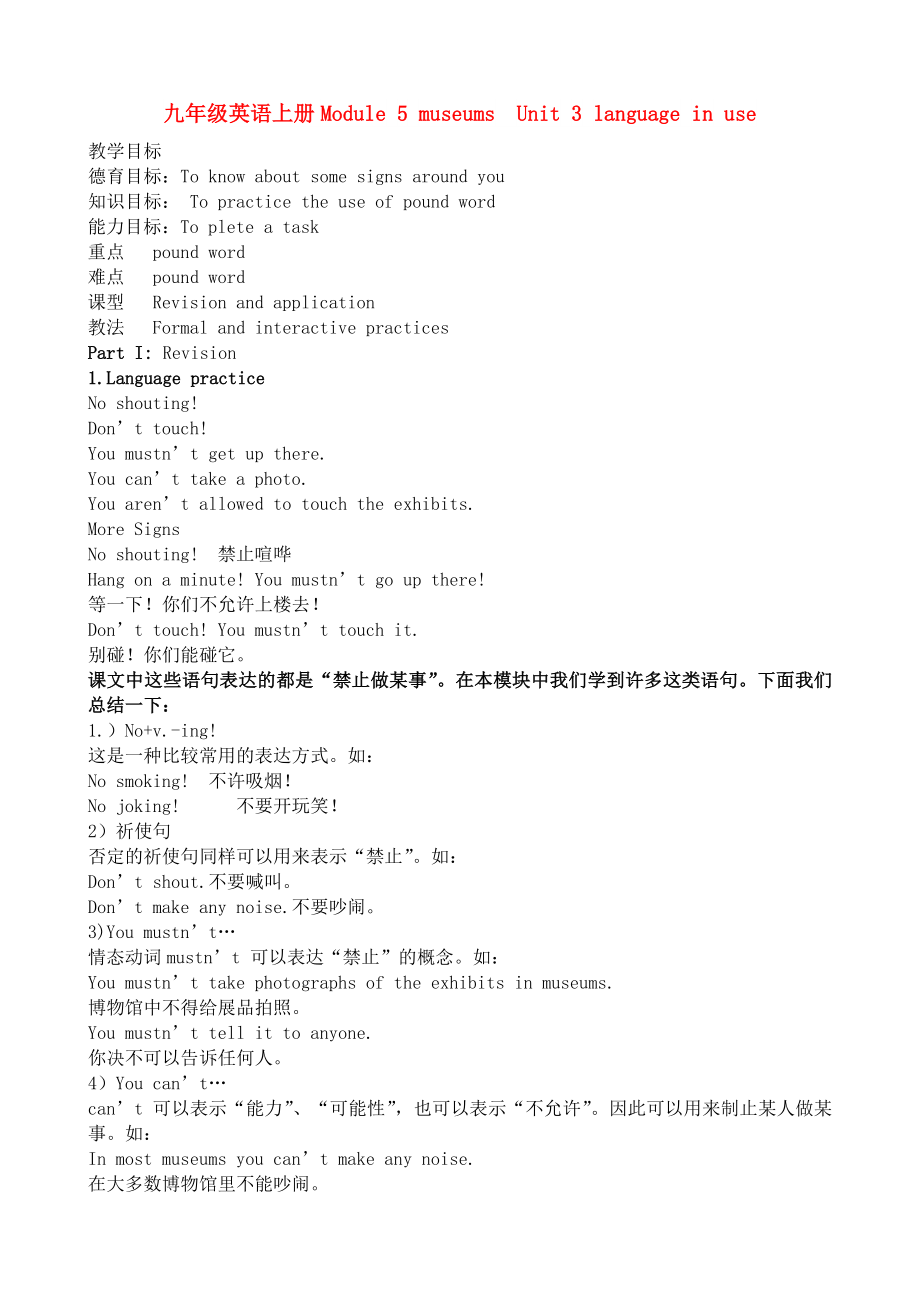《九年級英語上冊Module 5 museumsUnit 3 language in use》由會員分享��,可在線閱讀�,更多相關(guān)《九年級英語上冊Module 5 museumsUnit 3 language in use(3頁珍藏版)》請?jiān)谘b配圖網(wǎng)上搜索。
1�、九年級英語上冊Module 5 museums Unit 3 language in use
教學(xué)目標(biāo)
德育目標(biāo):To know about some signs around you
知識目標(biāo): To practice the use of pound word
能力目標(biāo):To plete a task
重點(diǎn) pound word
難點(diǎn) pound word
課型 Revision and application
教法 Formal and interactive practices
Part I: Revision
1.Language practice
No
2、shouting!
Don’t touch!
You mustn’t get up there.
You can’t take a photo.
You aren’t allowed to touch the exhibits.
More Signs
No shouting! 禁止喧嘩
Hang on a minute! You mustn’t go up there!
等一下�����!你們不允許上樓去�����!
Don’t touch! You mustn’t touch it.
別碰�����!你們能碰它�����。
課文中這些語句表達(dá)的都是“禁止做某事”�。在本模塊中我們學(xué)到許多這類語句。下面我們總結(jié)
3���、一下:
1.)No+v.-ing!
這是一種比較常用的表達(dá)方式�。如:
No smoking! 不許吸煙�����!
No joking! 不要開玩笑�!
2)祈使句
否定的祈使句同樣可以用來表示“禁止”。如:
Don’t shout.不要喊叫���。
Don’t make any noise.不要吵鬧��。
3)You mustn’t…
情態(tài)動詞mustn’t 可以表達(dá)“禁止”的概念�����。如:
You mustn’t take photographs of the exhibits in museums.
博物館中不得給展品拍照���。
You mustn’t tell it to an
4�、yone.
你決不可以告訴任何人����。
4)You can’t…
can’t 可以表示“能力”、“可能性”�,也可以表示“不允許”。因此可以用來制止某人做某事��。如:
In most museums you can’t make any noise.
在大多數(shù)博物館里不能吵鬧��。
5)You aren’t allowed to…
本句型用來制止對方做某事���。如:
You are not allowed to touch the exhibits.
不要觸摸展品��。
1.Match the pictures and the rules
2.Look at the pictures and
5�����、 plete the rules
3. Write the short form of the words
Abbreviation (abbrv. )
TV' is an abbreviation for [of] 'television.
TV.是 television 的縮寫
4. pound words
Make new words using the words in Box A and Box B
5. Read the passage and answer the questions
1. Where can you find out the history o
6�����、f munication?
2. What outdoor activities can you do?
The city of Bath
Find one word in the passage which means:
Now write the words in the correct columns in the table
basketball
hill walking
6. plete the passage with the words and phrases in the box
classroom entrance hall homework
7�����、 lunch boxes school trip upstairs Space Technology spaceships subway
Today we went on a to theNatural History Museum. We travelled there by (1) . We all had our(2) in our school bags,and we stored them in the (3) of the museum.(Eating
8��、in the museum is against the rules.)Then we went(4) to look at the(5) room. It was fantastic!
There were(6) from all over the world on display,and lots of things like spacesuits and meal packs,etc. In the display cases,we weren’t allowed to touch any
9�、thing,but there was an opportunity to try out some of the astronauts’ equipment—as long as we didn’t damage it! When we came back to our(7) ,we were told to write a position called “l(fā)ife in space” for (8) . I’m not really looking forward to that.
7.Write questions
what/s
10�����、ee/museum?
--What can you see at the museum?
Read the passage and answer the questions
8. Listen and label the different parts of the museum
9. plete the passage with the correct form of the phrases in the box
arrive at as long as as well e back drop in hurry up
look forward to
11���、 pay attention to think about work out
A visit to the museum
Please stay together,and let’s(1) and begin. The visit starts on the ground floor.(2) the information about ancient technology. It’s very important to (3)
12�����、 ______________how it helped with farming. Take(4) you want to look at everything, because we won’t(5) .
Then we’ll go upstairs to the first floor. After we(6) the Inventors of the 20th Century room, please read the invention storied and look at some
13���、 modern inventions(7) . While you look at these inventions,(8) how they pare with the ancient technology.
When you have finished looking at the exhibits, take the lift up to the fourth floor. You can (9) ____________at the café for a drink, but don’t stay too lo
14、ng. You can find mare information on the museum’s website, and you can download everything you need. I’m(10) reading the reports of your visit.
Around the world The Palace Museum
Module task: planning a guide to a museum
A general description of the museum: what sort of museum it is,and what you can see there
Factual information: provide a map and directions for getting to the museums; say what the
opening hours are,give ticket information,etc.
A dialogue of the museum: show what you can find on each floor
Homework
Finish off the workbook exercises
 九年級英語上冊Module 5 museumsUnit 3 language in use
九年級英語上冊Module 5 museumsUnit 3 language in use

